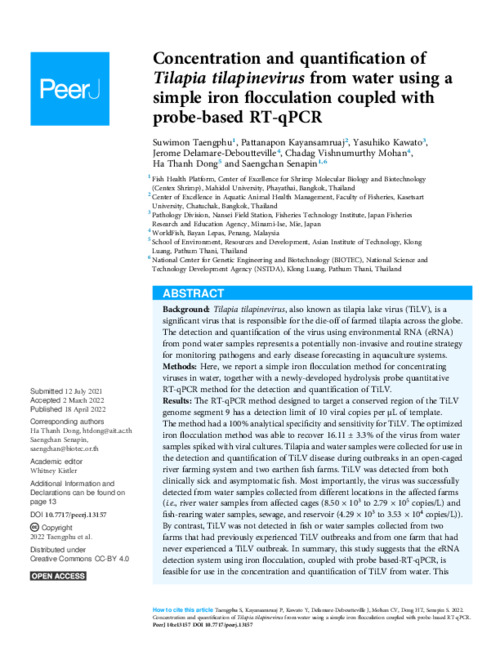Concentration and quantification of Tilapia tilapinevirus from water using a simple iron flocculation coupled with probe-based RT-qPCR

Background: Tilapia tilapinevirus, also known as tilapia lake virus (TiLV), is a significant virus that is responsible for the die-off of farmed tilapia across the globe. The detection and quantification of the virus using environmental RNA (eRNA) from pond water samples represents a potentially non-invasive and routine strategy for monitoring pathogens and early disease forecasting in aquaculture systems.
Methods: Here, we report a simple iron flocculation method for concentrating viruses in water, together with a newly-developed hydrolysis probe quantitative RT-qPCR method for the detection and quantification of TiLV.
Results: The RT-qPCR method designed to target a conserved region of the TiLV genome segment 9 has a detection limit of 10 viral copies per µL of template. The method had a 100% analytical specificity and sensitivity for TiLV. The optimized iron flocculation method was able to recover 16.11 ± 3.3% of the virus from water samples spiked with viral cultures. Tilapia and water samples were collected for use in the detection and quantification of TiLV disease during outbreaks in an open-caged river farming system and two earthen fish farms. TiLV was detected from both clinically sick and asymptomatic fish. Most importantly, the virus was successfully detected from water samples collected from different locations in the affected farms (i.e., river water samples from affected cages (8.50 × 103 to 2.79 × 105 copies/L) and fish-rearing water samples, sewage, and reservoir (4.29 × 103 to 3.53 × 104 copies/L)). By contrast, TiLV was not detected in fish or water samples collected from two farms that had previously experienced TiLV outbreaks and from one farm that had never experienced a TiLV outbreak. In summary, this study suggests that the eRNA detection system using iron flocculation, coupled with probe based-RT-qPCR, is feasible for use in the concentration and quantification of TiLV from water. This approach may be useful for the non-invasive monitoring of TiLV in tilapia aquaculture systems and may support evidence-based decisions on biosecurity interventions needed.
Permalink
Date Available
Type
Publisher
ISSN
2167-8359
Copyright
CC-BY-4.0
Research Themes
Topics
Language